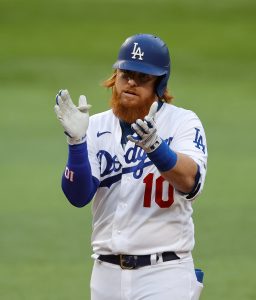Justin Turner isn’t in the starting lineup for Game 2 of the NLCS, as Dodgers manager Dave Roberts said the third baseman is battling a neck stinger. “He couldn’t turn his head to the right,” Roberts told MLB.com’s Juan Toribio and other reporters. “Justin will do anything we ask, but I just don’t think it’s right to put him in that spot, and for us as a club, I think we have other options also.” Chris Taylor will instead get the start at third base in Turner’s spot.
The injury first occurred during batting practice prior to Game 1, though Turner was well enough to play and went 1-for-4 in the Dodgers’ 3-2 loss to the Braves. Roberts hopes Monday’s off-day will allow Turner to be ready for Game 3 on Tuesday, and Turner might only be used today in an emergency pinch-hit scenario. Turner has yet to get going this postseason, as his hit in Game 1 was just his third of the playoffs; the veteran has only a .381 OPS through 30 plate appearances.
More injury notes from the postseason bracket…
- Max Muncy updated reporters (including Bill Plunkett of The Orange County Register) yesterday on the status of his dislocated left elbow. While “the range of motion has actually been pretty decent the last couple days [and] we’re able to get more movement in it than we thought,” Muncy admitted that “it’s just one of those things where it’s not really close to normal and probably won’t be. If we’re able to play, it’ll be essentially gutting through.” Muncy said he has been participating in some unspecified rehab that may or may not be baseball activity-related, though he is also wearing a brace on his left arm at almost all times, even while sleeping. The Dodgers didn’t include Muncy on their NLCS roster and it remains to be seen if he can be healthy enough to participate in the World Series, should Los Angeles get past the Braves.
- Right knee discomfort forced Luis Garcia out of yesterday’s ALCS Game 2 in the second inning, though the Astros right-hander appears to have avoided serious injury. Manager Dusty Baker told FOX 26’s Mark Berman (Twitter links) and other reporters that Garcia threw a bullpen session today, and the righty himself said “I feel really good, and I think whenever they say it’s time for me to get back on the mound I’ll be good to go.” It isn’t known when Garcia might be able to pitch again, or if he’d be used in a starting or a relief capacity. Garcia only threw 33 pitches in Game 2, but was also torched for five runs on three walks and two hits, including a J.D. Martinez grand slam.
- Baker also told Berman and other media that Jake Meyers was throwing today, and the outfielder is doing better in the wake of his left shoulder injury from Game 4 of the ALDS. Meyers collided with the outfield wall in pursuit of a Gavin Sheets home run and had to leave the field in the second inning. The Astros included Meyers on their ALCS roster though he has yet to make an appearance against the Red Sox.
